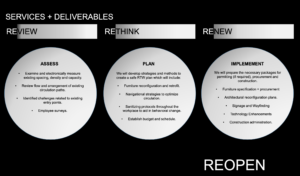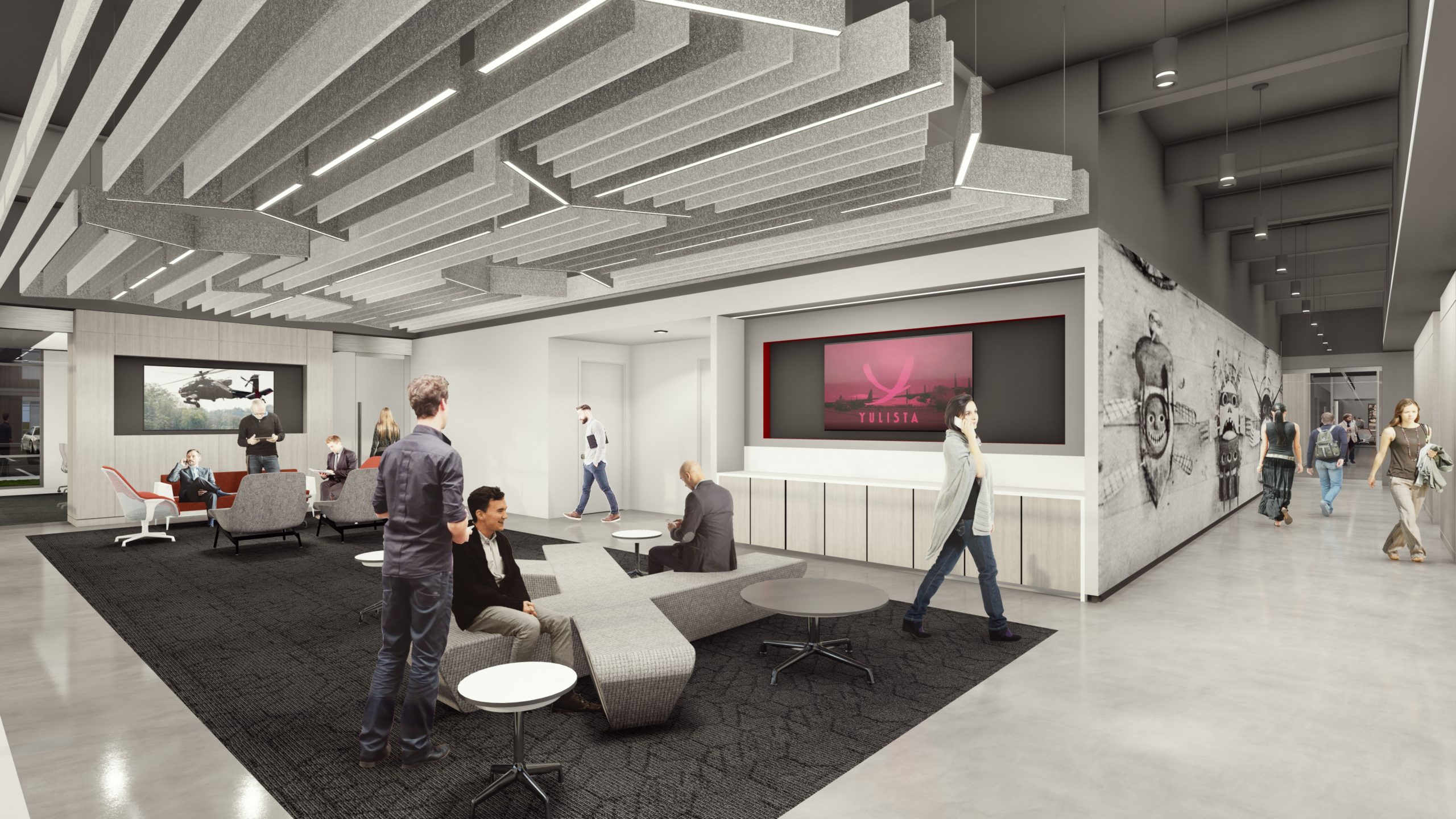By Katie Rapone, editor.
As restrictions are lifted surrounding the global economic crisis of COVID-19, businesses will reopen and organizations will begin to bring workers back into the physical workplace. The safety of their employees is paramount in this process and many companies are looking to the CRE industry to provide guidance to help them navigate their reopening. We spoke to two architecture/interior design firms who are working to establish a framework for their office and retail clients to follow.
Office
Prior to the pandemic, open plan offices and a coworking environment was the norm for many but offices stand to look a little different upon reopening, and their overall safety will require a lot more than merely wearing protective masks and gloves and using hand sanitizer.
In response to this new normal, Lauren Amber Prestenbach, NCIDQ, LEED AP ID+C, EDAC, principal of Powers Brown Architecture, and the firm’s Interiors team, created the Safe Work Return Roadmap, a turnkey package for the design and implementation of best workplace practices for 2020 and beyond. Its goal is to modify a client’s work environment in alignment with CDC and local government recommendations to provide the utmost in safety, efficiency and wellbeing
This streamlined and highly customized Roadmap will include concise, well documented action items for the long-term that will offer the customized, affordable solutions, while maintaining the space’s aesthetic integrity.
Powers Brown Architecture has created a turnkey three-step approach to reopening: REVIEW, RETHINK, RENEW. The process involves a strategic space assessment that looks at the existing layout to identify the hotspots and rethink the operational layout.

The firm’s approach to multi-sector service offerings allows them to collaborate with some of the top talent across various industries and in so doing, be able to make strategic recommendations that encompass Zoning, Sterilization, Circulation, Sanitization, Privacy and Materiality.
Powers Brown Architecture recently consulted with their client Summit Utilities at United Properties Inova II office building in Centennial, to modify the space for reopening. “With this project we were able to zone it out in a manner that did not require any architectural changes, it was more application of product placement,” said Prestenbach.
The Powers Brown Architecture team worked with Summit to; implement the required protocol for circulation; identify zones for external and internal meetings; add anti-microbial sleeves on certain materiality such as door handles; strategic placement of sanitization stations; add filtration systems; as well as the addition of UV light portals and features that can be installed above hardware.
“We have talked about changing door handles leading into the office space. We are learning that the material that pathogens have the least effect on is copper and so if you change out hardware and layer that with sanitizing light application, you have a double layer of safety.”
However, even with the addition of this technology, many companies will still have to scale back the number of employees that they bring into the office, which could ultimately have a negative impact on company culture and morale. “A lot of these benching stations that are all the rage for high density plans are not going to work anymore, so thinking about a work from home concept whereby half the staff work at home one week and the other half work in the office is one solution,” says Prestenbach.
Obviously, the cost of adding technology such as this is significant—ranging around 40 cents/square foot, according to Powers Brown Architecture—but spending some money up front to help prevent an outbreak can really help avoid a lot of unnecessary costs for both the tenant and the landlord down the line.
Retail
With many retailers announcing closures and/or bankruptcy, restoring confidence in retail is paramount for its survival. Mike Riggs, managing director of retail with national architectural firm IA Interior Architects has over 25 years experience in environment design and retail strategies across a broad spectrum of categories. IA’s retail division is currently working with its clients to fulfill the basic requirements in order to open their doors and welcome back guests and shoppers back safely.
“Although retail as a category has been impacted like none other due to the global economic crisis of COVID-19, many brands see an opportunity to recover more quickly than they did following previous crises, putting some projects on temporary hold rather than wholesale project cancelations,” says Riggs.
How this pandemic will impact the future of retail design remains to be seen but Riggs predicts a more minimal aesthetic that must include increased sanitation standards, low/no touch in-store interactions, and traffic and crowd modeling for social distancing. Other opportunities include increased levels/types of voice controlled, touchless employee/guest experiences. “Options could potentially include guest/employee cleansing entry portals, antiviral mist, UV lighting, and/or self-diagnose terminals,” says Riggs.
According to CBRE, overall, retail is seeing an acceleration of change due to COVID-19 that was already happening in the market. Savvy retailers have expanded use of convenience formats to enable customers to choose how they want to engage. Retailers who may be preparing to reopen should consider instilling a culture of safety first and foremost in all decision making, listening to employees and customers and being willing to adapt, and empower managers to have localized solutions—no one-size-fits-all approach.
“This transition will likely be more of an evolution rather than a revolution, converging cross-category learnings from existing solutions,” says Riggs. “This will either be supported by a reversion to known consumer and retailer behaviors or lead to an everlasting shopping paradigm shift.”
IA believes that the brands that embrace, or had already embraced, the idea of altruism and doing good over the consumption of goods will have an advantage in winning the hearts, minds, and wallets of their customers.









